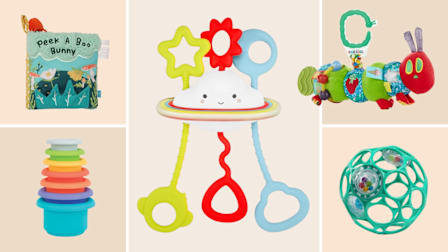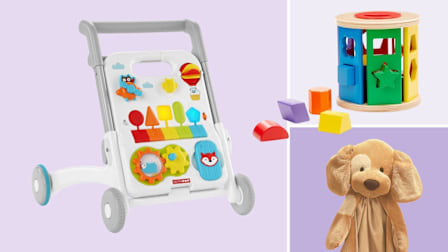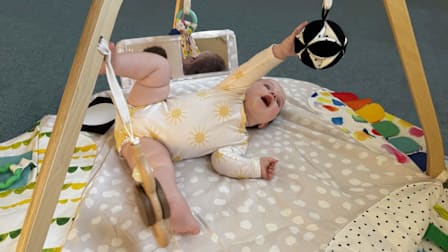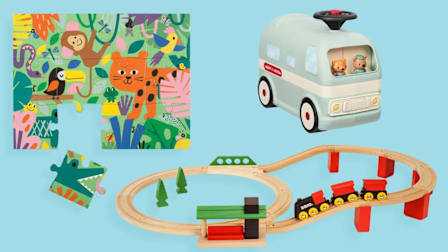How to Safely Clean and Disinfect Your Baby’s Toys
You probably think sanitizing your kids’ toys regularly is necessary, but in most cases, it may not be
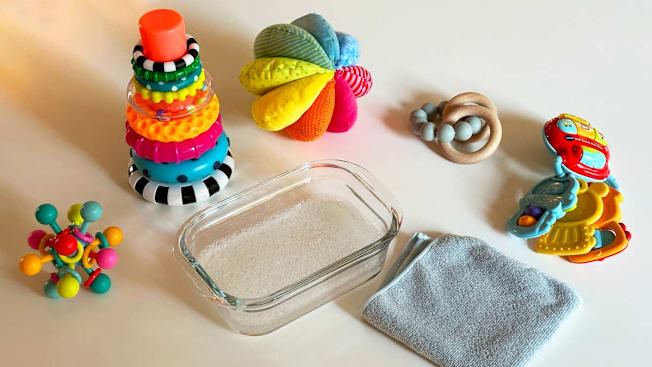
Depending on how old your children are, there’s a good chance they’ve had their toys in their mouths at least once today. With cold and flu season well underway, it’s understandable that you’d want to make sure your kiddos aren’t getting sick from their favorite toys at home, but you can’t exactly toss all of their toys into the washing machine or dishwasher and hope for the best. Legos, stuffed bears, and squeaky rubber ducks all have to be cleaned using different methods.
We spoke to experts to learn the best way to clean our kids’ toys, what products to use and not to use, and when disinfecting and sanitizing are necessary. Spoiler alert: Disinfecting and sanitizing don’t have to happen as often as you’d think.
- Are Sanitizing and Disinfecting Toys Necessary?
- How to Clean Toys by Material: Plastic Toys Wooden Toys Bath Toys Electric Toys Plush Toys
- Toy Cleaning Products to Use and Avoid
Do You Need to Disinfect or Sanitize Your Children’s Toys?
First, it’s important to understand the difference between cleaning, disinfecting, and sanitizing. Cleaning removes dirt and other debris from the surfaces of objects. According to the Environmental Protection Agency, sanitizing kills bacteria but not viruses, and disinfecting kills both bacteria and viruses on the surfaces of objects.
See our reviews of the best toys for babies, 1-year-olds, and 2-year olds.
How to Clean Kids’ Toys by Material
Now that we’ve cleared the air on disinfecting and sanitizing, let’s discuss how you should actually clean your toys at home. Before trying any of these cleaning tips, make sure you check the manufacturer’s cleaning instructions to avoid damaging your kids’ favorite toys. It’s also important to make sure toys are allowed to dry thoroughly after you’ve cleaned them.
Plastic Toys
Plastic toys are arguably the easiest to clean. For plastic toys that don’t have any electronic elements, your dishwasher is your friend. “I recommend always placing them on the top rack,” says Kathy Cohoon, operations manager at Two Maids, a home cleaning franchise business. And if you have lots of small plastic toys, like Lego, she recommends placing them in a dishwasher-safe mesh bag or container before you load them into the dishwasher.
If you don’t have a dishwasher in your kitchen, cleaning plastic toys is still fairly straightforward. Forrest Webber, founder of Bear Brothers Cleaning, a commercial and home cleaning service based in Birmingham, Ala., says plastic toys are his favorite to clean. “A quick soak in warm water with dish soap does the trick.”
Wooden Toys
Wooden toys are a little trickier to clean than plastic because wood is porous. Instead of soaking them in water, use a damp cloth dipped in your cleaning solution of choice (water and dish soap, or water and vinegar) to wipe the surface of the toy, says Cohoon. Knighton says drying is as important as cleaning, especially for wooden toys. “Moisture can be a breeding ground for more germs.” Allow wooden toys to air-dry for at least 24 hours after cleaning.
Bath Toys
The surfaces in your bathroom that come in contact with water often are more prone to developing mold and mildew, and the same applies to your kids’ bath toys. Several of the experts we spoke with cautioned against leaving water inside bath toys with holes, like rubber ducks and other squeeze toys. After bath time, squeeze any excess water out of the toys and allow them to air-dry completely (or better yet, choose bath toys without holes, like stacking cups). Webber recommends using a glue gun to seal the holes on bath toys and storing them in a well-ventilated area between uses. When it’s time to clean them, soaking in a 1:1 vinegar solution for an hour should do the trick.
Electric Toys
Plastic toys with electrical parts are a little bit more tricky to clean because you can’t toss them into the dishwasher or soak them in water. To clean these toys, use a damp microfiber cloth dipped in a vinegar solution to wipe the surface, making sure to avoid the battery compartment or any other areas that shouldn’t get wet.
Plush Toys
You should be able to wash most plush toys in the washing machine, but it’s important to read any tags carefully because submerging some loveys in water can ruin their stuffing. Cohoon and Webber both suggest placing plush toys in mesh laundry bags or a pillowcase and setting the washer to the gentle cycle to minimize the possibility of damage. They also both agreed that air-drying is the way to go here, rather than tossing plush toys into the dryer. “It’s best to use a mild detergent with cold or warm water, avoiding bleach,” says Cohoon.
If someone’s been sick at home and their plush toys are not machine-washable, Knighton says you have two options. “If the toy isn’t machine-washable, try spot-cleaning with a fabric-safe disinfectant. Another option is placing the toy in a sealed plastic bag for a few days to minimize germ transmission.”
Which Cleaning Products to Use—and Which to Avoid—for Cleaning Toys
You probably already have the two most frequently recommended ingredients for cleaning kids’ toys at home: water and dish soap. Vinegar and water solutions are also effective for cleaning toys, but according to Glassy, vinegar does not disinfect or sanitize and should not be used if you’re concerned about harmful germs.
How to Choose Healthier and More Sustainable Cleaning Products
Here’s what to look for when shopping for cleaners and disinfectants.
Using cleaning products with harsh chemicals is not necessary. Knighton said that as an “infection preventionist,” she often shares information “on ways to reduce the spread of germs and effective ways to minimize exposure to harmful chemicals.” The products she recommends for cleaning toys include “diluted white vinegar [in a] 1:1 [solution], mild dish soap with warm water, hydrogen peroxide for things that need a deeper clean, [and] eco-friendly disinfectants such as Seventh Generation.” She echoed these thoughts for choosing laundry detergents to wash plush toys with, recommending parents choose fragrance-free, dye-free, or hypoallergenic detergents and run an extra rinse cycle to remove any detergent residue that could cause irritation.

















